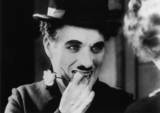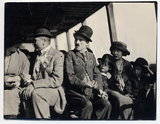The Professor
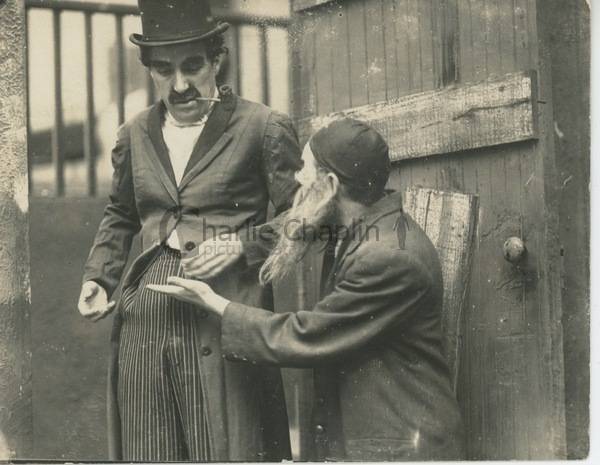
The Professor has often been considered as something of an enigmatic abandoned film in the filmography of Charles Chaplin. In what many consider the definitive Chaplin biography, Chaplin: His Life and Art (Penguin, revised second edition 2001), David Robinson calls The Professor, “the major mystery in the Chaplin canon.”
Though the film was never released, documents in the Chaplin archives suggest that the film did actually exist as a finished two-reeler. For years, however, it seemed that the only remaining scene was a five-minute cut sequence on a dosshouse set of Chaplin in the rare costume of “Professor Bosco”, the proprietor of a flea circus. This sequence was preserved in the Chaplin archives along with some outtakes from Shoulder Arms (1918) and Sunnyside (1919) in two cans labelled “The Professor”.
The flea-circus scene was included in Kevin Brownlow and David Gill’s acclaimed documentary series Unknown Chaplin (1983), which dates the footage to 1923, speculating that it was to be Chaplin’s last film for First National. The narrator (James Mason) asks, “What kind of film did he have in mind? It may always be a mystery.” However, we know from the daily production reports in the archives that the sequence was not shot in 1923 but from September 30th to October 2nd, 1919, during production of The Kid. The footage has more recently been featured as a bonus on the Limelight DVDs licensed by our distributors, MK2.
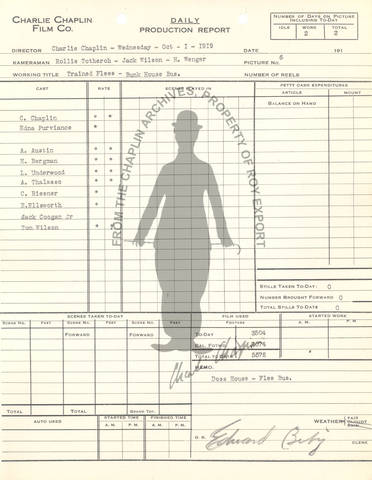
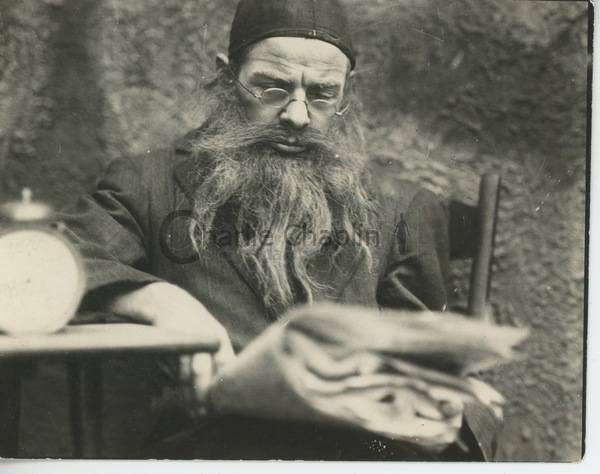
In Chaplin: His Life and Art, Robinson questions, “But of what did the rest of The Professor consist, if a two-reel version really existed? Had Chaplin or his cutter in fact assembled a new film out of rejected scenes, perhaps from Mutual as well as the First National series? There is no one living who can give us the answer, and unless the film itself one day comes to light, the mystery of The Professor will remain unsolved.”
Actually, we know now that Robinson guessed correctly. In November 1922, Chaplin did indeed assemble a new film out of rejected scenes from the First National series, as Paul Duncan wrote in The Charlie Chaplin Archives (Taschen, 2015). The complete, detailed synopsis below from the archives shows that The Professor was an assemblage of outtakes from Shoulder Arms and Sunnyside, as well as the unused flea-circus footage.
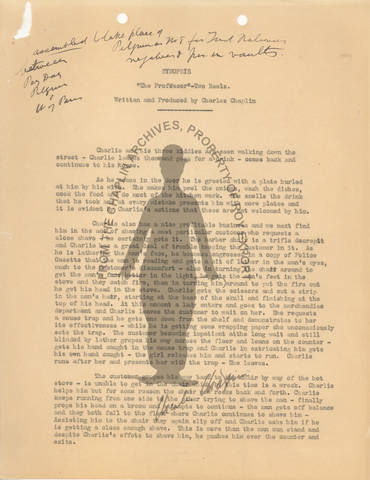
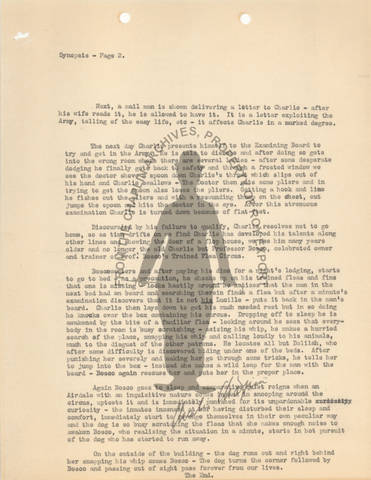
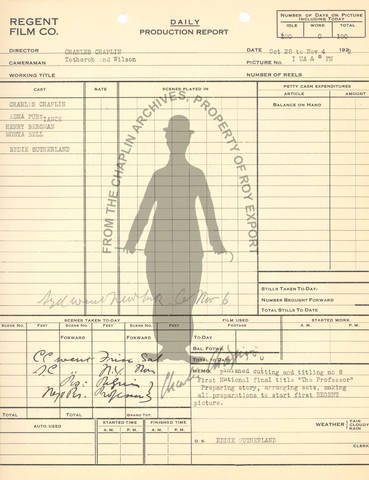
But why would Chaplin, the eternal perfectionist, think of putting these rejected sequences together as a new film in 1922?
Robinson describes in detail the acrimony between Chaplin and First National, especially in 1922 over distribution of The Pilgrim, his eighth and final film under his famous million-dollar contract. Chaplin refused to deliver the film to First National under the same terms as a normal two-reeler. Like The Kid, it was much more ambitious in scope than had been anticipated in the original deal. Chaplin’s brother Sydney was sent to New York to negotiate, and was given the following memorandum from Chaplin studios, which reads:
“The idea is, Chief wishes to deliver No. 8 ‘Pilgrim’ as a feature four reeler to terminate the contract. He thinks to let them have it on a 70-30 basis same as ‘Kid.’ […] Failing their acceptance of these terms, it is proposed you will deliver picture No. 8 as per contract, a two reeler entitled ‘The Professor’ for which he has received full contract price. […] Before exhibiting ‘Pilgrim’ or ‘Professor’ to First National (there being no compulsion on our part to give them a preview) they should agree that if they do not come to terms for ‘Pilgrim’ as a feature, they are to accept ‘The Prefessor’ [sic] as picture No. 8 in full termination of all Chief’s obligations to them under the Contract.”
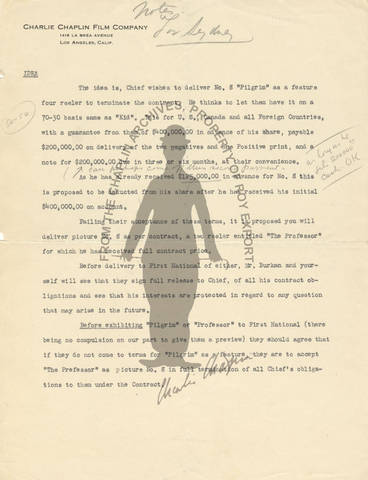
Several telegrams from November 1922 to January 1923 between Charlie and Sydney Chaplin indicate the difficulties in coming to an agreement with First National over The Pilgrim. If First National did not improve the terms of the deal, Chaplin would deliver the two-reel The Professor to them, and The Pilgrim to United Artists.
![December 7, 1922, Telegram from Charlie to Sydney Chaplin and Nathan Burkan (Chaplin’s New York lawyer): "FIRST NATIONAL EXCUTIVE [sic] HERE HAVING FAILED TO OFFER SUITABLE CONDITIONS FOR PRODUCTION OF SPECIAL FOUR REEL FEATURE PILGRIM IT NOW OK COURSE FOR YOU AND MR BURKAN TO DELIVER TWO REELER PROFESSOR IN ACCORDANCE WITH CONTRACT AND THEIR ACCEPTANCE OF THIS AS NUMBER EIGHT TERMINATES THE SERIES STOP REGARDS CHARLES CHAPLIN"](/images/photos/0000/2296/ch05503001_big.jpg)
Relations between Chaplin and First National were so strained, that he seriously considered passing an assemblage of rejected scenes as his eighth and final film under contract. But an agreement was eventually found, and The Pilgrim was released by First National in early 1923. Though The Professor was abandoned, Robinson observes that Chaplin never really abandoned the flea circus gag, “which he tried to work into The Circus [1928] and The Great Dictator [1940] before finally putting it on screen in Limelight [1952].” He also used the name Professor Bosco for the magician in The Circus:
It is thanks to the scanning and cataloguing of our archives by the Cineteca di Bologna, that it is now so easy to access documents in the archives. In fact, at the Chaplin office we regularly come across treasures when searching for something else, like the six-page shot list of The Professor, complete with intertitles and camera transitions.
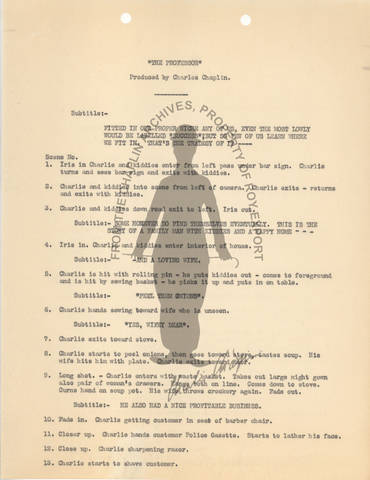
Thanks to these six pages we were able to “reconstruct” The Professor in 2018 for the first time since 1922:
Though Chaplin was hoping to incorporate the flea-circus footage into The Professor in 1922, it was not specifically shot for a film with that name in 1919. In Chaplin: Genius Of The Cinema (2003), Jeffrey Vance quotes Chaplin in a 1957 interview with Margaret Hixman:
“There’s one joke that I’ve always wanted to use. I thought of it as long ago as The Kid, but I couldn’t find a spot for it in that film. It’s a man with a flea circus. He goes into a dosshouse … [a]nd the fleas get loose. He runs around searching for the fleas, calling them by name. Everyone is scratching furiously. Finally, he manages to round up all the fleas but one. There’s a big man with a great straggling beard. He spots a flea in the beard, picks it out, studies it intently, then says ‘Sorry, wrong one’ and puts it back. And the pay-off is when a scrawny old dog starts scratching itself. The flea trainer sees it, makes a grab for the dog; and it races off down the street with the little man, calling his lost fleas, chasing after. I used a little of that in Limelight, but I’ve never been able to fit the whole episode in anywhere.”
Article by Arnold Lozano
